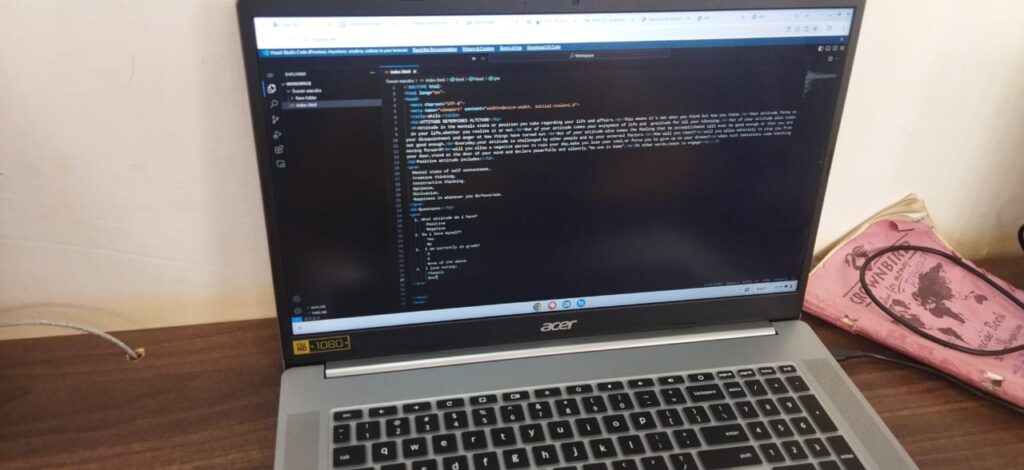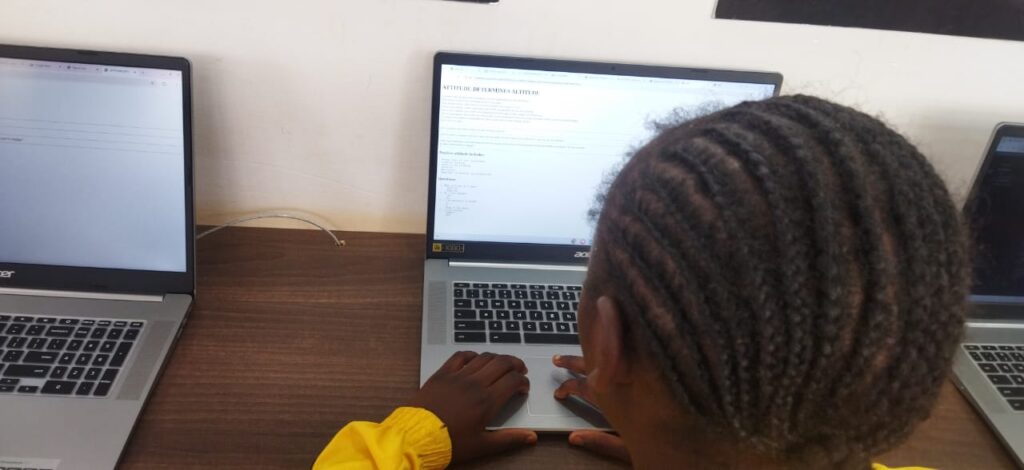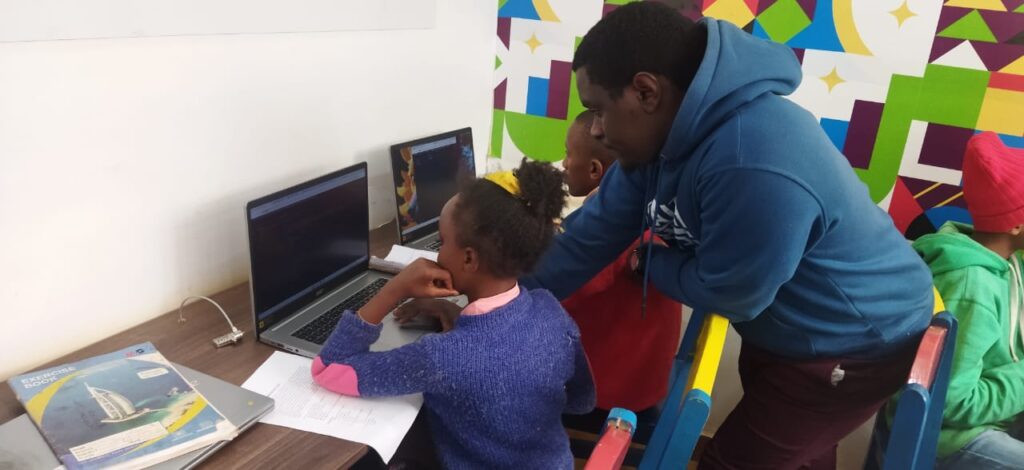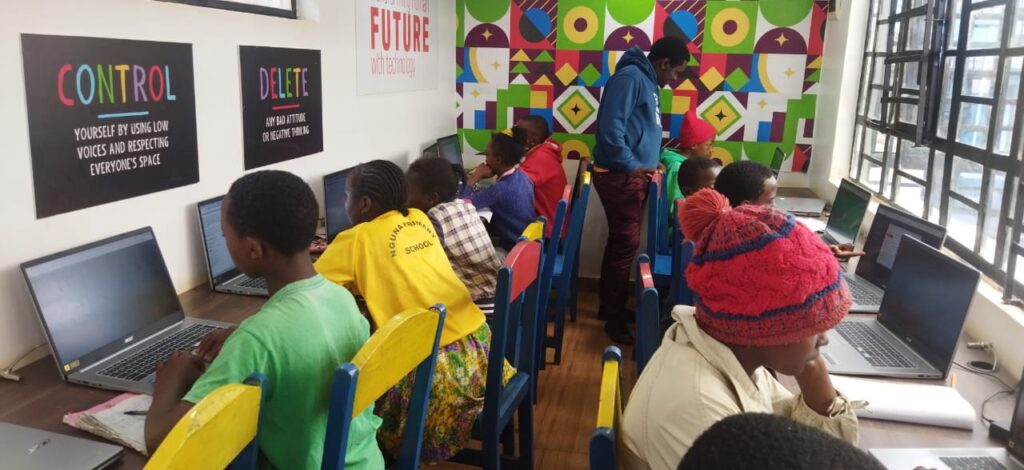Coding For The Future: A Glimpse into Kairi’s Digital Revolution
inableAdmin
In the serene village of Kairi, tucked away in Thika, a quiet digital revolution is unfolding. During school holidays, like the recently concluded August break, this once-sleepy village transforms into a technological hub. The catalyst? The Kang’aru Digital Hub, powered by inABLE, has embarked on a mission to equip local students with digital skills that promise to reshape their academic journeys and unlock new career opportunities.

A picture of a Chromebook with coded work by the learners.
A Structured Learning Experience
The coding classes are meticulously structured to cater to different age groups and educational levels. The morning sessions, running from 9:00 am to 11:00 am, are dedicated to students in grades 6 and 7 from Kairi and Nguna Primary Schools. In the afternoon, from 2:00 pm to 4:30 pm, form two students from Rumwe School take over the computers, diving deeper into the world of programming.
The curriculum is both comprehensive and progressive, starting with an introduction to software development and then moving on to more specific programming languages and tools, including HTML (HyperText Markup Language), CSS (Cascading Style Sheets), GIT and GitHub, and JavaScript. The goal is clear: to lay a strong foundation in coding that students can build upon as they advance in their education.

A learner doing coding by herself on a Chromebook laptop.
“We’re already seeing great progress, especially with the students from Nguna Primary School,” says Kelvin Karanja, inABLE’s Coding Instructor leading the classes. Kelvin, a graduate of Meru University of Science and Technology with a degree in Business Information Technology and a certified Full Stack Software Developer from Moringa School, is passionate about bringing these skills to rural communities. “This is just the beginning,” he adds. “As the project grows, we plan to introduce UI/UX design and backend programming languages, particularly Python.”
Making Learning Accessible and Engaging
To ensure the classes are accessible and engaging for all students, Kelvin has employed several strategies. “We use PowerPoint presentations, encourage peer-to-peer learning, and provide a list of YouTube videos for students to watch after class to reinforce what they’ve learned,” he explains. Customized examples that relate directly to the students’ everyday experiences also help to demystify complex concepts.

A picture of Kelvin Karanja, a Coding Instructor, assisting pupils during a Coding Lesson.
The response from the students has been overwhelmingly positive. Many of the grade seven students have shown a keen interest in learning beyond the curriculum, even exploring new programming concepts through YouTube tutorials that have not yet been covered in class. “The energy during the classes is motivating,” says Kelvin. “In the next six months, I’m confident we’ll have some tangible success stories to share.”
Overcoming Challenges
The journey hasn’t been without its challenges. One of the major hurdles has been balancing the students’ schoolwork and household responsibilities with their coding classes. Time constraints have made it difficult for students to practice their coding skills outside of class, as they have limited access to computers at home. To address this, Kelvin has adjusted the teaching schedule to allow for more hands-on practice during class time.

A picture of students using Chromebook laptops during a coding class. The students are seated down while the teacher is standing up.
Despite these challenges, the skills the students are acquiring go beyond just learning to code—they are learning to think critically and solve problems, skills that are invaluable in any academic or professional setting.
“In terms of academics, this training is fostering critical thinking, which will positively impact how students approach technical subjects like mathematics and sciences,” Kelvin explains. “Professionally, the skills these students are gaining will open numerous doors in the tech industry. They’ll be well-prepared for careers as software engineers, developers, DevOps engineers, cybersecurity experts, and more.”
The future of the Kang’aru Digital Hub looks bright. The plan is to continue expanding the classes, with the ultimate goal of producing Full Stack Developers capable of creating effective solutions to real-world problems. “We’re committed to introducing more engaging programming tools and expanding our curriculum to include additional programming languages and frameworks,” Kelvin asserts.
Kairi’s journey into the world of coding is just beginning, but the foundations being laid today will undoubtedly lead to a brighter tomorrow for these young minds and their community.
For more information on the Kang’aru Digital Hub and how you can support this transformative initiative, click here.
Written by Kelvin Karanja, Coding instructor; Hezbon Karianjahi, Librarian and Lily Ronoh-Waweru, Strategic Communications Specialist